|
See more photos by Mike Legeros
By 1784, the Hand in Hand Fire Company was organized. This is the first
documented reference to organized fire protection in Charleston. In 1801,
the first hand engine company was formed, named the Charleston Fire
Company of Axeman. Other volunteer fire companies followed and organized
in the decades before the Civil War. They operated hand engines, as did
slaves who manned city-purchased "ward engines." The first steamer
appeared after the Great Fire of 1861. The Charleston Fire Company of
Axeman purchased the first steam engine and changed their name to the
Pioneer Fire Company. In 1865, the Charleston Hook & Ladder Company was
formed.
By 1870, over a dozen fire companies and 1,600 volunteers were serving the
city of Charleston. In 1877, a Gamewell electric-telegraph fire alarm
system was installed. In 1881, there were 17 fire companies and nearly
1,110 volunteers. That year, a paid fire department was organized. On
January 1, 1882, the Charleston Fire Department was placed in service with
six engine companies, two truck companies, 101 men, and 29 horses. They
utilized the equipment and facilities of the volunteer companies.
In 1892, the first aerial ladder was delivered, a horse-drawn apparatus.
In 1905, the first motor vehicle was placed in service, a car for Chief O.
G. Marjenhoff. In 1910, the first motor hose wagon was delivered. In 1913,
a Marine Division was started, utilizing three private tugs. In 1915, the
first motor pumper was delivered. In 1923, the first motor aerial ladder
was placed in service. Also that year, a pair of Indian motorcycles were
placed in service for responding to still alarms. Three years later, the
department was fully motorized, except for a fuel wagon and reserve
apparatus. In 1943, the last reserve horse was retired.
|
Vigilant Fire Company
46 State Street
Built c.1817
Presently office
This two-story building was built by the city for the
Vigilant Fire Company. In 1849, the volunteers relocated
across the street the 33 State Street. The 1,296 square-foot
building was later restored in the 1970s as part of the
Lodge Alley complex. Charleston County Public Library photo. |
|
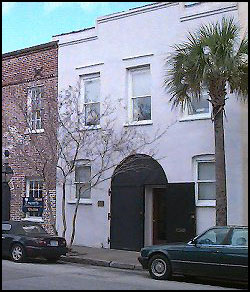
|
|
Vigilant Fire Company
33 State Street
Built 1849
Presently office
This was the second
location of the Vigilant
Fire Company, which operated a hand engine and later an 1871
Silsby second-size steam engine that was drawn by horses.
They ceased operation after
a paid Charleston Fire Department was placed in service on
January 1, 1882.
The building, measuring 3,316 square-foot, served a variety
of subsequent uses including as a maritime union hall and
a grocery store in the 1950s. It was adapted as a residence
in 1959. Mike Legeros photo.
|
|
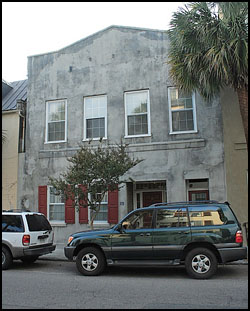 |
|
Old Station 3 /
Palmetto Fire Company
27 Anson Street
Presently residence
Built c.1850
This Italianate-style station was designed by architect
Edward C. Jones for the volunteer Palmetto Fire Company.
They operated a hand-engine, and later an 1867 Amoskeag
second-size steam engine that was drawn by hand.
The two-story building became Charleston Fire Station 3 on January 1, 1882.
It served until 1887-88. The 3,196
square-foot structure was converted to an apartment building
in the 1940s, and into a single-family residence in 1986.
Mike Legeros photo.
|
|
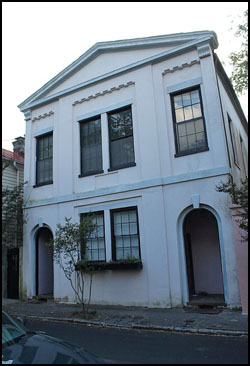 |
|
Old Station 1 /
German Fire Company
8 Chalmers Street
Built 1851
Presently law office
Architect Edward C. Jones also
designed this mix of Gothic Revival and Romanesque Revival
styles for the volunteer German Fire Company.
It replaced an earlier, smaller structure, and adjoined a
slave market.
The two-story building became Charleston Fire Station 1 in 1882 and served
until 1887-88. The company's horse-drawn 1870 Amoskeag
first-size steamer was placed in service of the city.
The building then served as the armory for the Carolina
Light Infantry until 1907. The building was used by black fraternal groups
until 1937. It was remodeled into a law office in 1981. Mike Legeros photo.
|
|
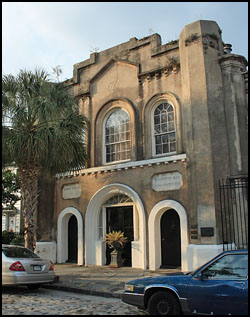

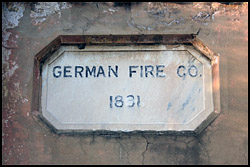
|
|
Young American Fire
Company
16 Hayne Street
Opened c.1866
Presently stable
Built in 1847, this stuccoed brick building
served the volunteer Young American Fire Company. The fire
company was
formed in 1866 and soon operated an 1871 Silsby second-size
steam engine that was drawn by hand.
The two-story building was rebuilt around 1872 and served as
a fire station until the city fire department started
operation in 1882. By that year, the fire company was
operating a hand-pulled Silsby steamer. Mike Legeros photo.
|
|
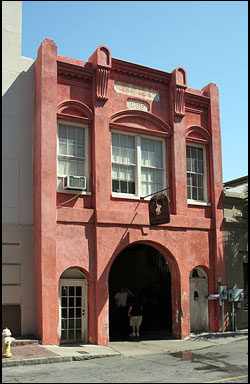
|
|
Central Station
262 Meeting Street
Built 1887-88
On August 31, 1886, the city of Charleston was struck by an
earthquake. 2,000 buildings were damaged, and between 60 and
100 people
were killed. Many fire stations were also damaged, the city
built a trio of larger and more strategically located fire
stations. The three buildings were each designed by Daniel
G. Wayne and built by Colin M. Grant.
The largest of the three was a double "double house" that
opened at the corner of Meeting and Wentworth Streets in
1888. Considered the most important station in the city,
because of its central location and straight passage from
each end of the city, the new station housed four steam
engine companies when it opened.
In 1900, a drill tower was built beside the station. The
70-foot structure was replaced in 1916, and closed in 1935.
Since
1976, Central Station has housed the Fire Chief's Office. It presently houses
two engine companies, a Battalion Chief, an Assistant Chief,
and several pieces
of antique fire apparatus.
The outdoor pavilion, built on the site of an 1846
Artesian well, includes monuments to fallen Charleston firefighters, and the bell
from the Cannon Street station watch tower. Mike Legeros
photo.
|
|
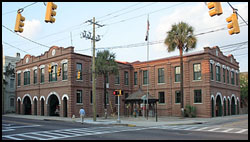

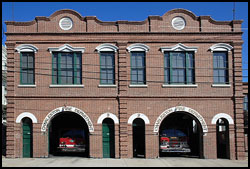

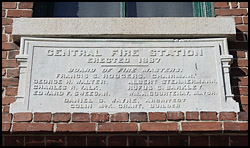

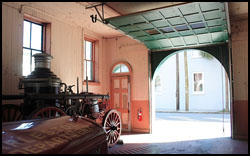

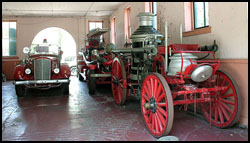
|
|
Old Station 1
112 Meeting Street
Built 1887-88
Presently city offices
The second new fire station built after the 1886 earthquake
was a new Station 1. It replaced the former Aetna Steam Fire
Engine Company quarters on Queen Street and was first
equipped with horse-drawn steam engine and horse-drawn hose
reel, and a reserve steam engine. The station also
housed the fire department offices and the equipment of the
fire alarm system. A watch tower was located behind the
station.
In 1930, a brick maintenance shop was added behind
the building. The station closed in
1976, and Engine 1 was relocated to 262 Meeting Street. The
building was converted to house city offices at a cost of
$215,000. Mike
Legeros photo.
|
|
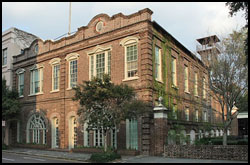

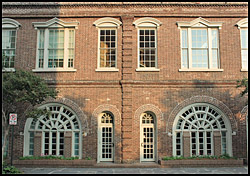

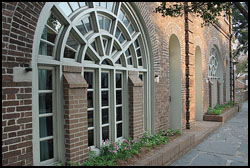
|
|
Station 6
5 Cannon Street
Built 1887-88
The third fire station built after the 1886 earthquake was a
new Station 6. It replaced the former Marion Steam Fire
Engine Company just down the block.
Each of the three stations had a Silsby boiler on the first
floor, for both heating and keeping hot water circulating at
all times in the steamer.
Like the Meeting Street station, this building also featured a watch tower
in the rear. It was later named Station 7, and
presently houses Engine 6 and a Battalion Chief. Mike Legeros photo.
|
|
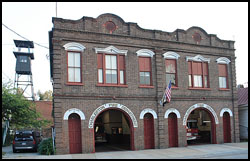

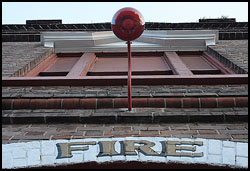
|
|
Station 8
370 Huger Street
Built 1910
The first fire station located on the Upper Peninsula was
designed by City Engineer James Hervey Dingle
and cost $9,575.
Engine 8 was placed in service on April 15, 1910 with an
1870 Amoskeag Steamer, a hose wagon, eight firefighters, and
likely four horses.
The station lot is surrounded by a brick
wall, and the fire department's only surviving outhouse is
located in the rear. Mike Legeros photo.
|
|
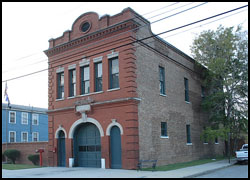

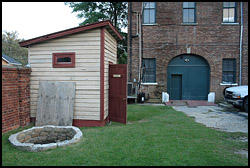
|
|
Old Station 9
1095 King Street
Built 1933
Presently gym
This two-story brick building was
designed by David B. Hyer and built by Simons-Mayrant & Co.
Opened around June 1, 1933, and dedicated on August 21,
1933, it cost approximately $4,200.
The first floor housed a single apparatus, kitchenette / dining room, lavatory, furnace
room, and a desk. The second floor had a large
dormitory and officer's room, beds and lockers for ten men,
tiled shower bath, and a lavatory. Mike Legeros photo.
|
|
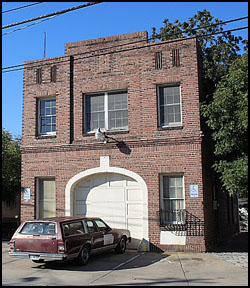 |
|
Truck
House
161 Coming Street
Built 1943
The city's first ladder company was stationed on John
Street, in a two-bay building located between Meeting and
King Streets. The fire company, which operated a horse-drawn
service ladder truck, was also comprised entirely
of African-American firefighters. Aerial ladders were placed
in service in 1892 (horse) and 1923 (motor).
In 1943, this
two-story brick building was constructed on land donated for
the purpose of housing African-American firefighters. Truck
1 and Truck 5 were initially housed at the station,
operating an American LaFrance 75-foot aerial ladder and a
Mack Motor City service ladder truck. It presently houses Truck 4 and Engine 15.
Mike Legeros photo.
|
|
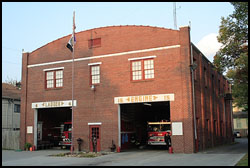

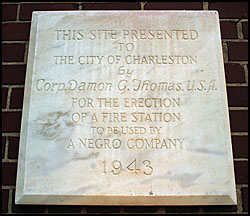 |
|
Old Watch Tower
80 Meeting Street
Built 1756
The 186-foot steeple of St. Michael's Protestant Episcopal
Church served as a watch and alarm tower until the late 19th
century. It also served as an observation post during the
Revolutionary War, a signal station during the Civil War,
and an air raid siren station during World War II. Mike
Legeros photos.
|
|

|
|
Old Watch Tower
Behind 5 Cannon Street
Built 1887-88
In 1877, Charleston was the fifth city in the world to
install a Gamewell electric-telegraph fire alarm system.
When the paid fire department was placed in service in 1882,
the alarm system was upgraded.
Each of the 96 alarm boxes triggered the simultaneous
striking of three bells. The boxes were also locked, with
keys carried by all policemen and firemen. Keys were also
available at the residence nearest the alarm box.
Two of the three bells hung in the guard houses of the city.
In 1888, they were moved to new towers built behind 5 Cannon
Street and 112 Meeting Street.
|
|

|
|
Old Watch Tower
Behind 112 Meeting Street
Built 1887-88
The bells, which each weighed 2,500 pounds, were cast by
Mennelly & Co. of West Troy, NY. The third bell, weighing
3,000 pounds, hung in the cupola of the Charleston Orphan
House on Calhoun Street.
The bells rang on all fire alarms until 1927, and then only
on second and third alarms. They also alerted the city to
hurricanes, severe temperature changes, and notable national
events. The bells were silenced in 1953, due to the
unavailability of parts for the strikers.
The Cannon Street bell was later relocated outside Central
Fire Station, while the Orphan House bell was damaged during
demolition of the building in 1952.
|
|
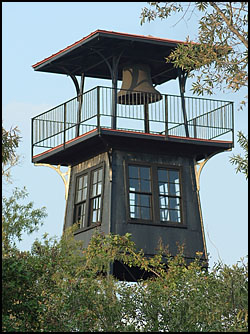
|
|
Other Former Fire
Stations
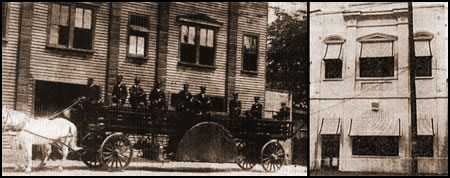
Truck House on John Street, photo
courtesy Evening Post. Phoenix Fire Company house on
Cumberland Street, photo courtesy News & Courier.
Nearly two dozen other buildings were
used as engine houses by both the volunteer fire companies and the paid
city department, as well as for storing the equipment of the ward engine companies.
All are believed demolished. Notable
structures included:
-
Old Reserve Station / Old Station 2 / Aetna Fire Company
at 81-83 Queen Street.
-
Old Station 5 / Hope Fire Company, Archdale Street
opposite Market Street.
-
Old Station 6 / Marion Fire Company
on Cannon Street.
-
Old Truck House / Hook & Ladder Company
on John Street, east of King Street.
-
Ashley Fire Company on Columbus
Street, corner of Hampstead Mall.
-
Charleston Hook & Ladder Company on Wentworth Street near King Street.
-
Comet Fire Company on Beaufain
Street, east of Smith Street.
-
Eagle
Fire Company on Meeting Street, between John and Ann streets.
-
Niagara Fire Company at 45
Spring Street.
-
Phoenix Fire Company on
Cumberland Street.
-
Phoenix Fire Company at 44
Wentworth Street.
-
Pioneer Fire Company on
Wentworth Street.
-
Salvage Corps at 8 Liberty
Street.
-
Stonewall Fire Company on
George Street at College Street.
-
Washington Fire Company on
Vanderhorst Street, between St. Phillip and King streets.
|
|
Map

|
References
-
The Buildings of Charleston: A Guide to
the City's Architecture
Author Jonathan H. Poston for
Historic Charleston Foundation, University of South Carolina Press,
Columbia, 1997
-
Charleston Fire Department History
Information compiled by Mike Legeros and
Grant Mishoe.
-
Charleston County Public Library, Main
Branch
Vertical files and other resources including
city directories, city yearbooks, include city
directories, oral histories, newspaper clippings, photographs, and a
document titled The Charleston Fire Department: A History of the
Department and its Stations by Niki Riesberg.
-
Charleston County Public Library Guidebook
Online guide to historic buildings.
-
Sanborn Fire Insurance Maps via
University of South Carolina
Charleston insurance maps from 1884 and 1888
are available online in complete form.
-
South Carolina Historical Society
Vertical files, including hand engine and
steam engine research in 1994 by Edward R. Tufts and an essay titled Early Days
of Fire Fighting in Charleston, S.C. by Harold S. Walker.
|